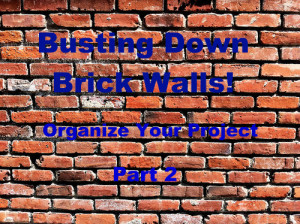Here is part two in the blog post series all about busting down your brick walls by organizing your project. If you missed part one, you can read it here.

3.) List Your Hypotheses. What are your educated guesses to answer your research question? What do you think may have happened? What is your reasoning behind your guess?
4.) Create the F.A.N. List: When researching your ancestors, it is super important to keep a list of the people your ancestors interacted with throughout their lives. These people are called F.A.N.s – friends, associates, and neighbors. These are the people your ancestors did business with, sat next to in church, and signed documents as witnesses. When you get really stuck with an ancestor, it is often the friends, associates, and neighbors that will have more information – research the F.A.N.s and you might find the missing piece of the puzzle to your research question.
5.) Create a To-Do List: Now that you have all information about your ancestor and the research problem laid out in a clear and organized manner, it is time to create a research to-do list. Carefully look at the information and begin to brainstorm the records and resources you want to check. Maybe you need to employ a new search strategy – like trying different naming spellings or checking the surrounding counties – to a resource you’ve already checked to find your ancestor.
6.) Collaborate: Collaborating with other researchers is a great way to find new perspective and get new research ideas. Whenever I have a research problem, I share the problem with others – two heads (or more!) are always better than one! I love to write blog posts about my brick wall ancestors – this will hopefully attract unknown cousins that might have information to share, and other researchers can have a chance to make recommendations or share resources I hadn’t thought of yet. Someone else might look at your research and have a fresh perspective to offer – like maybe you read a word incorrectly or didn’t know that geographic boundaries had changed and you should be looking in a different jurisdiction for that record.
If blog posts are you’re style, use a message board to share your problem. Like a blog post, other people can comment with ideas and fresh perspective – and you might just find a cousin!
Also look into using collaborative websites like WikiTree (my fav – and not just cause I work there!) or WeRelate. Both of these options allow for multiple researchers to collaborate on one ancestor profile.
7.) Re-Evaluate & Repeat: As you finish steps 1-6, you’ve hopefully gathered some new information. Now repeat the entire process, entering in all new information, until you have successfully answered your question.
—-
So that’s it for this blog series – have you busted down any brick walls lately? Tell me about it in the comments below!
[Photo: Flickr User Jayel Aheram, text added by Elyse Doerflinger]
